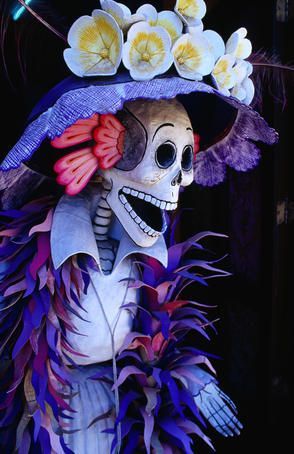Caitlin Doughty's Blog, page 38
October 28, 2015
Dia de Muertos – A Primer
In recent years, Day of the Dead – Dia de Muertos, has become increasingly popular. After all, who wouldn’t be enamored with colorful sugar skulls and smiling skeletons – but what do you REALLY know about the history and meaning behind this sacred practice? Not to worry, I’ve got you covered, in this primer on day of the dead observances.

San Gregorio Atlapulco, in Mexico City, 02 November 2006. Photo by Luis Acosta.
History
First, let’s delve a little into Mexico’s history. Pre-Hispanic Mexicans possessed extremely complex ideas and practices surrounding death and the dead. These are especially evident as you begin to explore their mythology and creation stories. Many of Mexico’s indigenous peoples observed a month long “Little Feast of the Dead,” involving ritual offerings to the dead, the God of Death and feasting.

Much has been written regarding the horrors of the Spanish conquest of Mexico. What we can extract from this period is the incredible tenacity Mexicans exhibited when it came to maintaining their death rituals and relationship with the dead. Although the church gave the directive to eradicate their “pagan” practices of honoring their ancestors – under severe punishment and torture – they continued. In result, the Spanish established mandatory burial in church graveyards, created laws controlling and abolishing funerary and mourning practices, created a grave tax and in the late 1700s, issued a series of laws that included the following edict:
“The use of food and private banquets on burial days, during funerary commemorations or on the Days of the Dead is absolutely forbidden and reproved.”
Their goal?
“So that these abominations can be entirely uprooted.”
With this constant siege from outside sources specifically targeting the Mexican’s relationship with death; it is evident that this was something of immense importance to them; that defined them and stirred their hearts. For centuries Mexico has fought to maintain and cultivate their unique and intimate relationship with death.
Modern Muertos
Modern Dia de Muertos is a period of days when it is believed that the souls of the dead return to visit the living. It is really like a family reunion.
The key elements of the celebration include cemetery vigils, the erection of home altars, the preparation of special sweets, the presentation of flowers, candles and food to the dead and the performance of ritualized begging.
Symbols and Icons
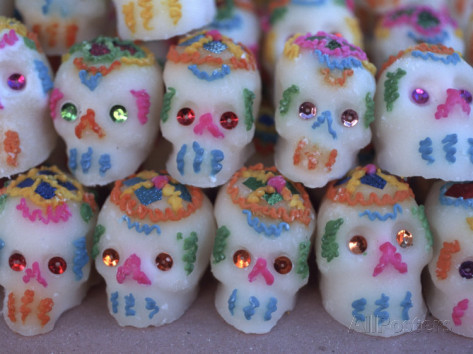 By the 1800s the wealthy were under pressure from the church to provide money, clothing and food to the poor when a family member died. It is in this context that the term, “una calavera,” a skull, was first used to signify funerary charity. The poor would approach funeral processions asking for “una calavera.” With regard to the calavera as donation, it is the poor who receive the contribution, as they become the symbolic surrogates of the souls in purgatory. Now, we give gifts of calaveras in the form of sugar skulls to children, assorted dependents and close friends.
By the 1800s the wealthy were under pressure from the church to provide money, clothing and food to the poor when a family member died. It is in this context that the term, “una calavera,” a skull, was first used to signify funerary charity. The poor would approach funeral processions asking for “una calavera.” With regard to the calavera as donation, it is the poor who receive the contribution, as they become the symbolic surrogates of the souls in purgatory. Now, we give gifts of calaveras in the form of sugar skulls to children, assorted dependents and close friends.
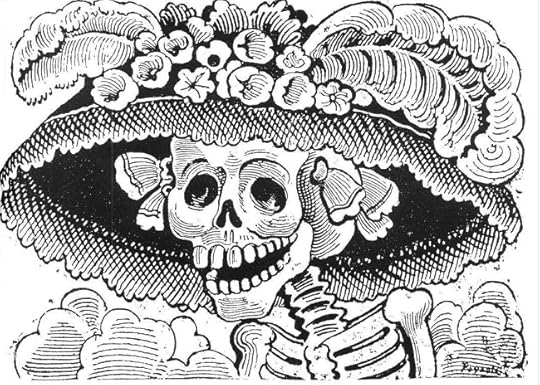 The other image most associated with Dia de Muertos emerged just prior to the beginning of the Revolutionary period in 1910. Here, the image that would arguably define Mexican identity emerged, The Catrina.
The other image most associated with Dia de Muertos emerged just prior to the beginning of the Revolutionary period in 1910. Here, the image that would arguably define Mexican identity emerged, The Catrina.
José Guadalupe Posada was a Mexican artist who was known for his political art, which frequently satirized the upper class. His iconic etchings of skeletons dressed in upper class finery were intended as a satirical portrait of those Mexican natives who, Posada and many others felt were aspiring to adopt European aristocratic traditions in the pre-revolutionary era. This attitude of casting aside one’s culture, after centuries of incredible efforts to preserve it, was infuriating to many.
Altars and Offrendas
Altars are made and decorated to display the offrendas – the offerings or gifts to the dead. These can be as simple as a table decorated with a few key items, to elaborate multi-tiered altars constructed by special builders.
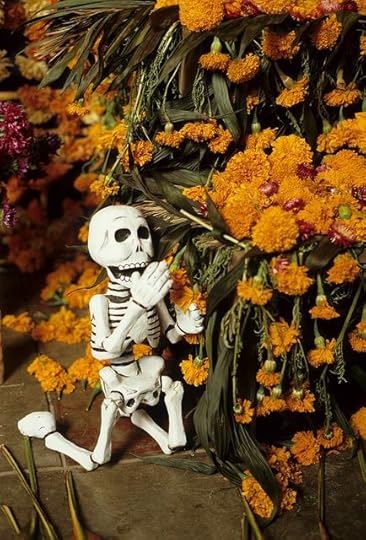
Skeleton and Cempasuchiles by Ilhuicamina on Flickr.
Common gifts are clothing, food, toys, personal objects and photographs. Anything the person enjoyed while living, we give to them in death.
Golden-orange flowers, cempasuchil play an important role, as the dead are able to follow their scent. Copal incense is also used in the same manner. Flowers are placed on altars and graves in abundance. Sometimes paths of their petals can be seen leading to a cemetery or into a house to help the dead find their way.
Feast
In the 1600s a friar secretly followed some Indians into a huaca, a cave where they interred their dead. There, the friar confronted them, stating how foolish they were to offer all this food to the dead, and asked the Indian Lord why they did it. He answered:
“I know father, that the dead do not eat the meat, nor the bones, instead they place themselves above the food and suck out all its virtues and the substance that they need and leave behind what they don’t need. And if this is not so, why do you allow the Spaniards to place bread, wine and goats on graves in the churches?” **
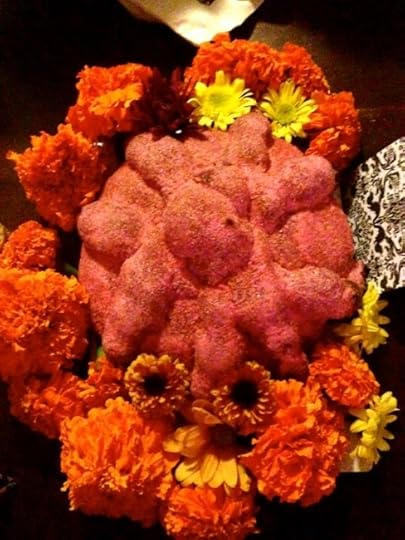
Pan de Muerto, made by the author for Death Salon: Los Angeles
Pan de muerto, bread of the dead, is made in the shape of a little grave mound with bones or made to look like a corpse. You can find pan de muerto everywhere, both inside and outside the cemeteries, in every panderia and even at Starbucks.
After the souls depart, the food like tamales, candies in the shape of coffins, skulls and skeletons are enjoyed by friends and family. Root vegetables, carrots and jicama are eaten around this time as it is believed that these things which grew under the ground were nourished by the corpses and this is another way we can be closer to the dead.
On the afternoon of October 31st to November 1st, it is time to receive Los Angelitos – spirits of the children who have died. When the spirits of the children arrive, we imagine it as though they are coming out of school, happy and excited to meet their loved ones.
The candles and incense is lit on the altars and people open the doors or go outside to receive them. Everyone sits near the altar and keeps the spirits company.
The following afternoon of November 1st, it is time for the adults to come and the same rituals are repeated throughout November 2nd. This is now a time for many to go to the cemetery to visit loved ones there.
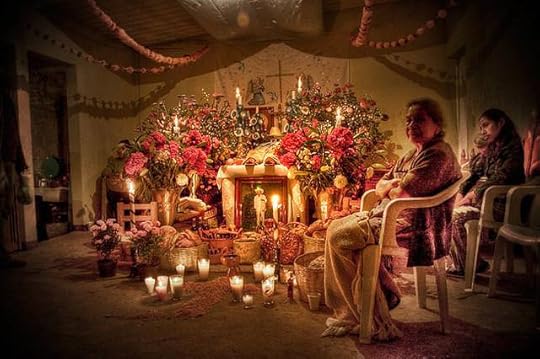
Día de Muertos in Ocotepec by elgatoenlaluna
Outside the cemeteries, there are huge markets selling various flower arrangements, food and toys. Inside, cemeteries are crowded and lively. Families carrying buckets of water up tall ladders to wash a grave, food vendors selling ice cream, children playing tag among the headstones or playing with toys right on top of a tomb. Family pets are brought to visit, there are strolling musicians to serenade the dead, families having picnics and laughing – the love and joy shared with the dead during these days is a poignant example of a culture that has cultivated a positive relationship with death.
Sarah Troop is the executive director of the Order, a museum curator and historian. As a Mexican-American she often writes and lectures about the inspiring, positive and often complex ways her culture engages with death and the dead.
**English translation quoted from Claudio Lomnitz, Death and the Idea of Mexico, 2008
Manuel Aguilar-Moreno, Handbook to Life in the Aztec World, 2007
Hugh Thomas, Conquest: Cortes, Montezuma, and the Fall of Old Mexico, 1995
Elizabeth Carmichael and Chloe Sayer, The Skeleton At The Feast, 1991
October 27, 2015
October 19, 2015
September 28, 2015
September 21, 2015
September 4, 2015
Calendar of Events – Fall 2015
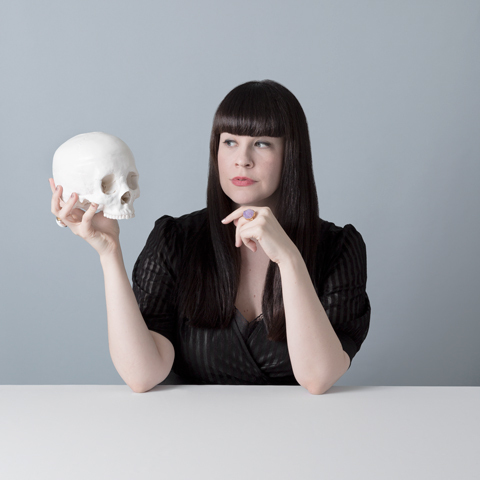
Photographer Juliette Bates
September 28, 7 pm at Book Soup in Los Angeles (8818 Sunset Blvd., West Hollywood)
September 29, 7:30 pm at Powell’s City of Books in Portland (1005 W. Burnside St., Portland)
September 30, 7 pm at Bookshop Santa Cruz in Santa Cruz (1520 Pacific Ave., Santa Cruz)
October 1, 7 pm at The Bone Room in Berkeley (1573 Solano Ave., Berkeley)
October 3, National Home Funeral Alliance Conference in Los Gatos (The Presentation Center, 19480 Bear Creek Road, Los Gatos)
October 4, 5 & 6 Death Salon: Mutter Museum in Philadelphia (Mutter Museum and various locations)
October 8, 7 pm, Strand Bookstore in New York City (828 Broadway, NYC)
October 9, 8 pm Morbid Anatomy Museum in Brooklyn (424-A 3rd Avenue, Brooklyn)
DEATH SALON
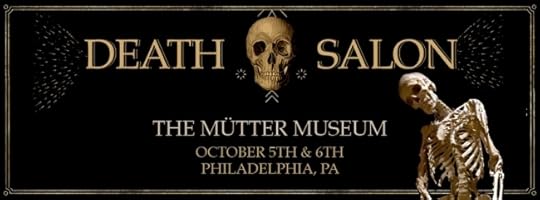
The Order’s own Death Salon will be taking place on October 5th & 6th, opening with a VIP Death Ball and including daytime and evening events and curated by Order member Megan Rosenbloom. In addition to the incredible talks and performances you’ve come to expect from us, we will also be featuring a Dark Artisans’ Bazaar. For the full lineup or to purchase tickets visit the Death Salon website.
ORDER MEMBERS
Carla Valentine will be will be speaking about her latest project, Remains To Be Seen: Engaging Audiences with Human Remains at the Ideal Death Show on September 5th in Winchester, UK.
Annabel de Vetten and Sarah Troop at Harold and Maude: An Evening of Film, Food and Funerals on September 27th in Los Angeles, California.
Nora Menkin will be presenting From Coffins to Corpses: Pulling Back the Curtain on the Funeral Industry at Death: OK in Portland Oregon on October 17th.
Paul Koudounaris will be doing a talk and showing his photographs at the Bram Stoker Film Fest in Whitby, UK on October 22nd – 25th.
Pia Interlandi will be conducting a dressing demonstration at Paper Garments For The Grave in Hobart, Tasmania on October 24th. Also, Pia’s organization the Natural Death Advocacy Network will be co-hosting a conference with the GroundSwell Project, Doing Death Differently: 2nd Annual Death Literacy Conference on October 9h – 11th in Melbourne, Australia.
Vanessa Ruiz will be speaking at TEDMED in Palm Springs, California on November 18th – 20th.
Elizabeth Harper will be presenting at the Bishop Walter F. Sullivan Catholic Studies Lecture Series on September 9th. Please see flyer for details.
INSTITUTIONS RUN BY ORDER OF THE GOOD DEATH MEMBERS
The following institutions are run by members of the Order and offer a full calendar year of death positive events that are open to the public.
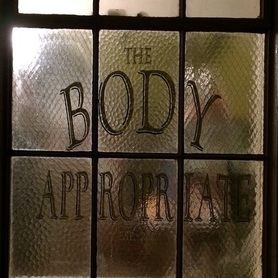 The Body Appropriate, located in San Francisco, is run by Order Member Stephanie Stewart-Bailey. This Fall season The Body Appropriate will feature a Postmortem Body Care Demonstration, A Sound Public Dissection, a Public Dissection and Anatomical Drawing. Check the entire schedule here.
The Body Appropriate, located in San Francisco, is run by Order Member Stephanie Stewart-Bailey. This Fall season The Body Appropriate will feature a Postmortem Body Care Demonstration, A Sound Public Dissection, a Public Dissection and Anatomical Drawing. Check the entire schedule here.

Join Technical Curator, Carla Valentine for an incredible array of events inside a stunning Victorian pathology museum in London. Throughout the Fall season you can attend a Dumb Supper, a feast honoring the dead, ‘pot’ a fixed animal organ to take home with you or spend a chilling evening exploring the scented worlds of Gothic movies. Check out these and so much more on the Barts Pathology Museum event page.
 Joanna Ebenstein’s incomparable Morbid Anatomy Museum in Brooklyn should be on every Deathling’s bucket list. In addition to visiting the museum you can catch any number of workshops, field trips, lectures and unique events. Coming up this season you can attend a taxidermy class, a Victorian Hair Art workshop or an illustrated lecture on Death and Disaster on the (Gramophone) Record. Visit their website for a full listing of events and visiting hours.
Joanna Ebenstein’s incomparable Morbid Anatomy Museum in Brooklyn should be on every Deathling’s bucket list. In addition to visiting the museum you can catch any number of workshops, field trips, lectures and unique events. Coming up this season you can attend a taxidermy class, a Victorian Hair Art workshop or an illustrated lecture on Death and Disaster on the (Gramophone) Record. Visit their website for a full listing of events and visiting hours.
OTHER DEATH POSITIVE EVENTS IN FALL 2015
The Ideal Death Show is weekend gathering of entrepreneurs, pioneers and progressives from the UK funeral industry.
When Death Comes is an art space and series of events where people can come together to think about, talk about, and create their own work about dying and living.
Death: The Human Experience an art exhibit that explores the human response to death through hundreds of objects and stories from across the world, from ancient times to modern day.
Death: OK, Let’s Talk About It is a day of inspiration, information & connection surrounding the subject of death.
Craig Young lecture, “Making a place for the dead: developing inter-disciplinary perspectives on contemporary encounters with dead bodies”
London Month of the Dead is a series of month long talks and activities about death.
August 31, 2015
Deathxpert Opinion: Organ Donation and Home Funerals
The short answer is “yes!” The realistic answer is “it depends.”
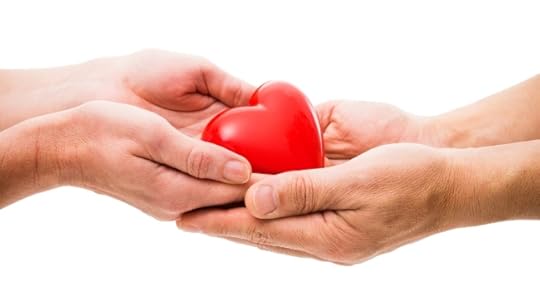 Let’s start with organ donation. Everyone’s organs are not created equal. In order to be a candidate to donate your vital organs (heart, lungs, liver, etc.), you must be an otherwise healthy individual who has fallen victim to an accident that has only affected your head or brain: vehicle collision, gunshot to the head, or brain aneurysm, for example.
Let’s start with organ donation. Everyone’s organs are not created equal. In order to be a candidate to donate your vital organs (heart, lungs, liver, etc.), you must be an otherwise healthy individual who has fallen victim to an accident that has only affected your head or brain: vehicle collision, gunshot to the head, or brain aneurysm, for example.
Let’s take the example of the bike rider who was unfortunately hit by a car. He wasn’t wearing a helmet and his head met pavement at considerable force. A bystander calls 9-1-1 and begins CPR until paramedics arrive. Paramedics use their machines to keep oxygen and blood flowing through his system to get him to the hospital for doctors to do what they can. Once in the hospital and on a ventilator, two physicians declare him braindead. The organ recovery team gets permission from his next-of-kin to recover organs for people waiting on the transplant list.
Once organs are recovered, the body goes to the coroner or medical examiner, since this was not a natural death. A cranial autopsy would be done to determine the exact nature of the brain damage that led to death. The medical examiner declares the death an accident (or even a homicide depending on the circumstances) and the body can then be released to a funeral home. 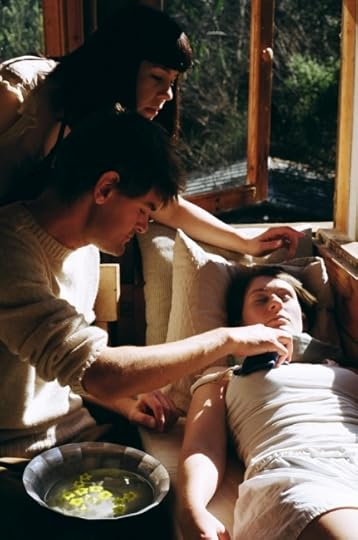
This is the point that a family wishing to have a home funeral would claim the body to take it home. If the medical examiner and organ recovery team have been kind, they have sutured the incisions they made doing their work. Unfortunately, this usually doesn’t happen but if the teams know that a home funeral will be taking place, they may be more accommodating.
An ideal home funeral situation has the person dying at home, immediately bathed, dressed, and cared for by the family, then left to lie in state for a few days before going to the crematory or cemetery. We should all be so lucky.
A family wishing to have a home funeral for someone who died due to more traumatic circumstances must have a stronger resolve for their mission, and likely a stronger stomach, for that matter.
Because of the donation procedures, the people handling the body are more likely to come in contact with blood and bodily fluids than if the person died at home under hospice care. Extra care and caution needs to be used in bathing and dressing the body. Anytime the body is moved or manipulated, there is potential for leakage. Sometimes funeral guides (and funeral directors) use superglue the keep the incisions closed.
Not to dissuade anyone from having a home funeral, but due to these circumstances, I would encourage the family to examine why they still want to have a home funeral. After the trauma it went through, the body will not look like the person it used to be. Sitting with the body in that condition for a few days might not be the memory a family wants to keep of their loved one. But, then again, it might be exactly what a family needs to come to terms with the death and to say good-bye.
“I am only one, but I am one. I cannot do everything, but I can do something. And I will not let what I cannot do interfere with what I can do.” ~Edward Everett Hale
Everyone thinks of organ donation as being hearts, lungs, etc. But there are other types of donation that more people qualify for, even without having died in a medical facility. As a bonus, they are less invasive to the body. Tissue donation includes skin, bone, and corneas which can be recovered within 6-24 hours of death. SightLife, our local Seattle organization that recovers corneas, does have an age limit of 73 for their donors. A person who died of natural causes at home can be taken to a medical facility or a funeral home’s care center for tissue and bone recovery. According to SightLife, they will work with a family to do a corneal recovery in the home. The other tissues need a sterile environment.
The cornea donation is pretty well hidden once the eyes are closed. To replace extracted bone, wooden rods or plastic pipes are sometimes used to give limbs a familiar structure. Skin grafts can be covered with a bandage. In fact, bandages can cover pretty much all the repair work that is done following donations or autopsies if a family wants to have a home funeral.
Now once a body has been through all of this, a home funeral is a bit more complicated, but still possible if that is what the family wants.
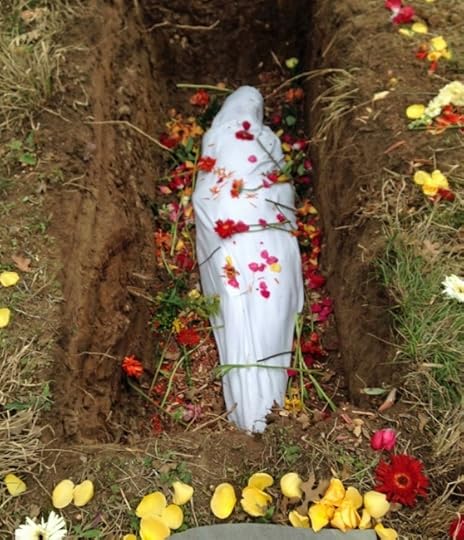 Moving on to natural burial, yes, of course, unequivocally, a body that has been an organ and/or tissue donor can have a natural burial. I’ve even requested that a bone donor have a wooden dowel used in lieu of plastic pipe to replace the donated bone since the family wanted natural burial. Though a natural burial ground would not reject a person with any prosthetic joints or other non-biodegradable implants.
Moving on to natural burial, yes, of course, unequivocally, a body that has been an organ and/or tissue donor can have a natural burial. I’ve even requested that a bone donor have a wooden dowel used in lieu of plastic pipe to replace the donated bone since the family wanted natural burial. Though a natural burial ground would not reject a person with any prosthetic joints or other non-biodegradable implants.
I encourage anyone who wants to have a home funeral to talk about it with their family so everyone can be prepared for a situation we all hope will never come to pass. The more conversations and education that people have, the more likely they are to be comfortable having a home funeral under any condition. It is always up to the family to decide what is right for them and their situation when the time comes.
August 18, 2015
PLEASE Help Pass the End of Life Option Act

Rally in support of the End of Life Option Act
Last month, as a concerned citizen I walked into my assemblyman’s office and asked to speak with someone. Did I, prior to that week, have *any* clue who my assemblyman was? No. No I did not. (Spoiler: It was Sebastian Ridley-Thomas, District 54) So if you don’t know who yours is, you’ll get zero judgement from me.
But it turns out these assembly members, men and women from all over the state of California, will very soon have the power to decide something that will change the face of dying. It’s called the End of Life Option Act.
As a mortician, I’ve heard story after story of suffering. The young man who found his father hanging in his apartment after the pain of end stage cancer became too much. The woman who asked, “Is it ok to be sort of glad my mother is dead, she just suffered so badly, it was impossible to watch.” I’ve seen members of my own family have what can only be called, kindly, the bad death.
The End of Life Option Act would allow terminally ill Californians to request medication to peacefully end their lives and free them from suffering. It’s been called Physician Assisted Suicide, but I’ve long since stopped using that term. These people don’t want to die. They would live long and happy lives if they could. But disease is taking their life from them, day by excruciatingly painful day.

The mother of Brittany Maynard after the bill passed the California Senate.
70% of Californians want this, no small majority. We know this type of law works, we have data from Oregon (the first state to allow this 18 years ago). There are safeguards in place. It is ready to go. It has already passed the California Senate! We are so. close.
There are people right now, terminally ill, who cannot wait for this legislative process to drag on. Cancer cannot wait, and California cannot wait.
Here is what you can do if you live in California (or KNOW anyone who lives in California- tell them!).
Type in your address here: http://findyourrep.legislature.ca.gov/
In just 10 seconds it will tell you who your State Assembly Member is.
STEP 1
Tweet at your assemblyperson. Facebook them! Take a photo of yourself with the hashtag #CAWontWait and make sure they see it.
STEP 2
Write them a letter, telling them why the End of Life Option Act is necessary and vital. Tell your own story.
Here are two easy to access letter links from Compassion & Choices:
SEND A LETTER IN SUPPORT VIA THE WEB
DOWNLOAD AND MAIL THIS LETTER IN SUPPORT
STEP 3 (Master Level)
March your butt into your assemblyperson’s office and ask to see someone.
It worked for me. Tell them, “I’m a constituent, and I’d like to be heard on the End of Life Option Act.”
Let’s do this together.
July 30, 2015
Caitlin Doughty's Blog
- Caitlin Doughty's profile
- 8410 followers


